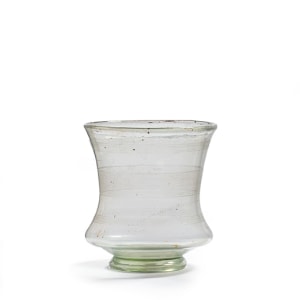Roman carinated beaker with wheel-cut lines, c.1st century AD
%3Cdiv%20class%3D%22title_and_year%22%3E%3Cem%3ERoman%20carinated%20beaker%20with%20wheel-cut%20lines%3C/em%3E%2C%20%3Cspan%20class%3D%22title_and_year_year%22%3Ec.1st%20century%20AD%3C/span%3E%3C/div%3E%3Cdiv%20class%3D%22medium%22%3EGlass%3C/div%3E%3Cdiv%20class%3D%22dimensions%22%3EHeight%3A%2010cm%3C/div%3E%3Cdiv%20class%3D%22price%22%3E%C2%A3%205%2C000%3C/div%3E
Blown in transparent, colourless glass. The waisted beaker has concave walls creating an overhang which tapers sharply to a ring-shaped foot, the body decorated with three bands of wheel-cut lines,...
Blown in transparent, colourless glass. The waisted beaker has concave walls creating an overhang which tapers sharply to a ring-shaped foot, the body decorated with three bands of wheel-cut lines, the lip everted and folded. Intact, very minor surface wear including minute pitting, and small surface chips on underside of base.
Pliny, in his Natural History XXXVI, 198, stated that "the most highly valued glass is colourless and transparent, as closely as possible resembling rock crystal".
Provenance
Robin Symes, shown at the Buxton Antiques Fair, UK, April 1966
Mrs Traudi (1922-2013) and Professor Peter H. Plesch (1918-2013), UK; acquired from the above, collection number AGh 10B
Their Sale; Christie's, London, 28th April 2009
Sheikh Saud Al-Thani (1966-2014), London, UK and Paris, France
Literature
Compare N. Kunina, Ancient Glass in the Hermitage Collection (St Petersburg, 1997), no.298, p.313
Publications
Christie's, London,The Plesch Collection of Ancient Glass, 28th April 2009, lot 6



